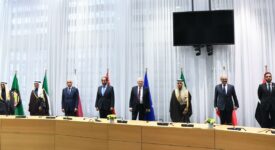Mobility between Morocco, as well as the rest of the Maghreb, and Europe has always been a feature of the shared history of Europe and North Africa. The colonial past, the geographic proximity and the economic and political realities in both areas have been major drivers of cross-border migration. This mobility of people has been paralleled since the late 1990s by a new current of mostly irregular migrants from sub-Saharan African countries crossing the Maghreb on their way to Europe.
In 2011-12, there was a new surge in movement along the western Mediterranean route as Syrian refugees sought to reach Europe via Gibraltar or the Spanish cities of Ceuta and Melilla, which are located in Moroccan territory. This flow peaked in 2015-16 with a “migratory explosion” off the Tunisian and Libyan coasts before levelling off in what could be called a “migratory peace” between Morocco and Spain. Thus, this structural evolution, due to ongoing social and economic crises and security chaos in a large part of the region, has produced many changes in migration patterns in the Mediterranean.
This has, in turn, seriously altered the political and security response by European and North African countries and their willingness to manage the regular migratory flows, to reduce irregular migration and to fight against all trafficking linked to those flows. It follows that Morocco, like Algeria, is seen as a country of relative prosperity in comparison with the African countries in the south of the Sahara. This perception has two important consequences: firstly, migrants think that on their way to Europe, they can stop there for a while and earn some money to finance the rest of their journey; and secondly, in case they fail in their effort to migrate, they hope to remain in Morocco, which would become their final destination “by default”.
Having experienced relatively peaceful migration flows between 2008 and 2015, in autumn 2013, Morocco adopted a new policy to manage migration on its own territory. This policy took a humanitarian approach aimed at the implementation of a national strategy to integrate migrants into Moroccan society. This new policy was considered the most forward-looking approach among all countries of the Maghreb, and even of the whole Africa. Still, based on our analysis of migration trends and the global situation, in particular at the human security level, it is evident that controlling the coastline, including the borders in the Maghreb from Morocco to Libya, will prove ineffective if the African continent continues to be characterized by the same forms of economic and political governance that are in place today.
It is also clear, given the actual level of wealth in Morocco and the means at its disposal, and given the security situation in Libya in particular, that the Maghreb as a whole will not serve as a strong buffer to protect Europe’s Mediterranean coasts and borders for the foreseeable future. Thus, even if Morocco, operating at the edges of the EU, does everything it can and collaborates fully with European migration policy, as has been the case primarily since 2014, this will not be enough to stem irregular migration to the north shore of the Mediterranean without the adoption of a new approach to security, economic and social conditions in the countries of departure and transit.
Ultimately, the management of migration from Africa needs to be conducted as part of a coherent and multilateral approach. In this context, migration policies in the Maghreb – similar to that adopted by Morocco in 2013 – must be implemented in partnership with sub-Saharan countries of departure. Such cooperation must include the signing of readmission agreements with every African country from which the migrants depart. Moreover, in the absence of effective cooperation between Morocco and Algeria, Morocco’s eastern border will continue to experience high migratory pressure, even if the two countries complete the “walls of protection” that they started building years ago between their respective territories.
‘Migration Dynamics in Play in Morocco: Trafficking and Political Relationships and Their Implications at the Regional level’ – Working Paper by Mehdi Lahlou – Barcelona Centre for International Affairs / CIDOB.
(The Working Paper can be downloaded here)







